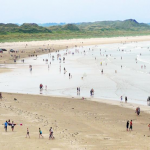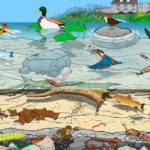The Bathing Water Directive (2006/7/EC) was transposed into Irish law…
The ‘Well of the River Ara Walk’ – embracing the river in Tipperary Town
Over sixty public sector officials who work to protect and restore water quality recently met at the South East Region Water Framework Directive Operational Committee’s quarterly meeting in Tipperary Town. They were impressed by the local ‘Well of the River Ara Walk’, a project that fuses urban planning and environmental stewardship while integrating water quality, nature, climate resilience, and community engagement.
Nestled in the heart of Tipperary town, the ‘Well of the River Ara Walk’ allows the community to walk alongside their river. Amidst concerns of poor to moderate water quality in the River Ara, a tributary of the River Suir, the walkway’s inception hopefully marks a pivotal shift towards embracing the river as a cherished environmental treasure while tackling challenges head-on.
The River Ara rises on the Tipperary/Limerick border and eventually meets the River Aherlow before linking with the River Suir en-route to Waterford and onwards towards the Waterford Harbour estuary beside Hook Head.
Conceived through a collaborative effort spearheaded by Tipperary County Council and the Department of Education, the project encompasses a playground, an outdoor classroom, wetland creation, and informative signages, weaving an intricate tapestry of biodiversity and education. Moreover, partnerships with local stakeholders, including Abbey CBS, underscore a shared commitment to community empowerment and environmental stewardship.

The River Ara Walk embraces inclusivity with wheelchair-friendly access, ensuring equitable enjoyment for all. Situated conveniently near the centre of town, its 1km loop beckons residents and visitors alike to immerse themselves in the wonders of nature.
Guided by Anthony Coleman and Dr Fran Igoe of the Local Authority Water Programme (LAWPRO), the tour unveiled the ideas behind the walkway’s conception and the barriers the project team encountered. Concepts such as large woody debris and climate adaptation underscored a holistic approach towards ecological restoration and resilience, incorporating multiple benefits and nature-based solutions.
Anthony Coleman, LAWPRO“A lot of work went into this project which started out as a proposal on the part of Tipperary Town Council many years ago. But it ran into a number of obstacles before eventually delivering what we have now which is a really important public walkway along the river and something which the town can be very proud of”
During the tour, samples were taken from the river by Dr Fran Igoe who demonstrated how testing is conducted. He also pointed out that the integrated wooded area through which the river flows, creates pools and ripples; helps to slow down the flow of water in a natural way; and provides the perfect conditions for promoting river and fish life. He even pointed out where a salmon or a large brown trout had spawned within a section of the river flowing through the park indicating that the river’s wildlife has the potential to recover if the water quality is improved.

The project team within Tipperary County Council accessed a range of funding streams and worked with the Local Authority Water Programme (LAWPRO), Inland Fisheries Ireland, the Tidy Towns and Abbey CBS, which owned much of the land, to develop the amenity which is being used widely by the community.
“You will not get a better example of an urban river for a project like this one – usually man has interfered with the river by taking out bends or altering the banks. With a bit of creativity and thinking, we have managed to achieve a lot in a short stretch. We have left it in as natural a state as possible and it is really great to see so many people using the walkway and enjoying getting closer to nature. The information boards will help people to understand what this is all about too”
Dr Fran Igoe, LAWPRO
Clare Lee, Climate Action Coordinator with Tipperary County Council also spoke about the new Tipperary County Council Climate Action Plan 2024 – 2029 which outlines plans for climate mitigation and adaptation across the county. Incorporating nature-based solutions into Council projects and infrastructure is crucial for enhancing resilience against escalating climate risks like floods and extreme precipitation.
Article by Noel Dundon








